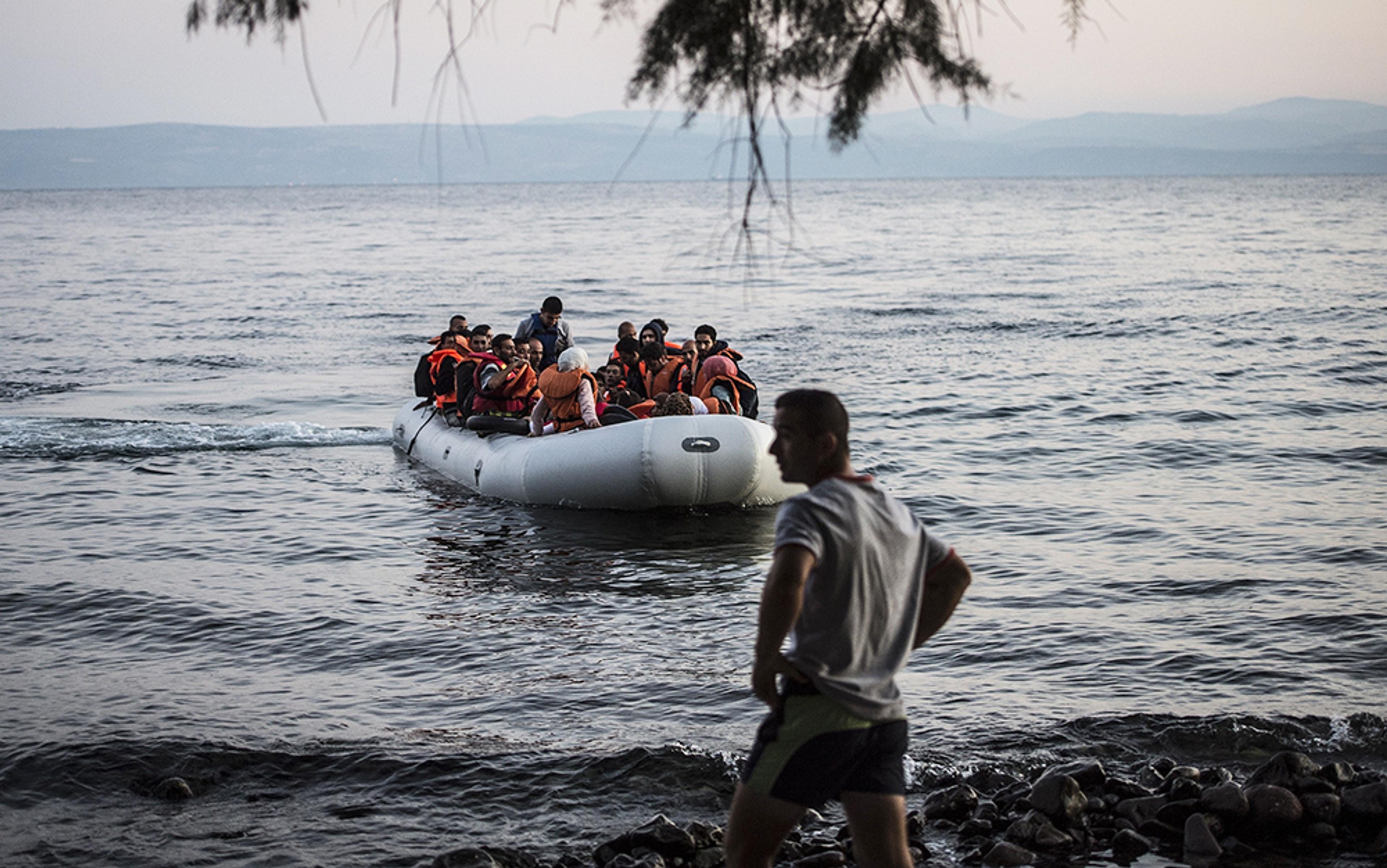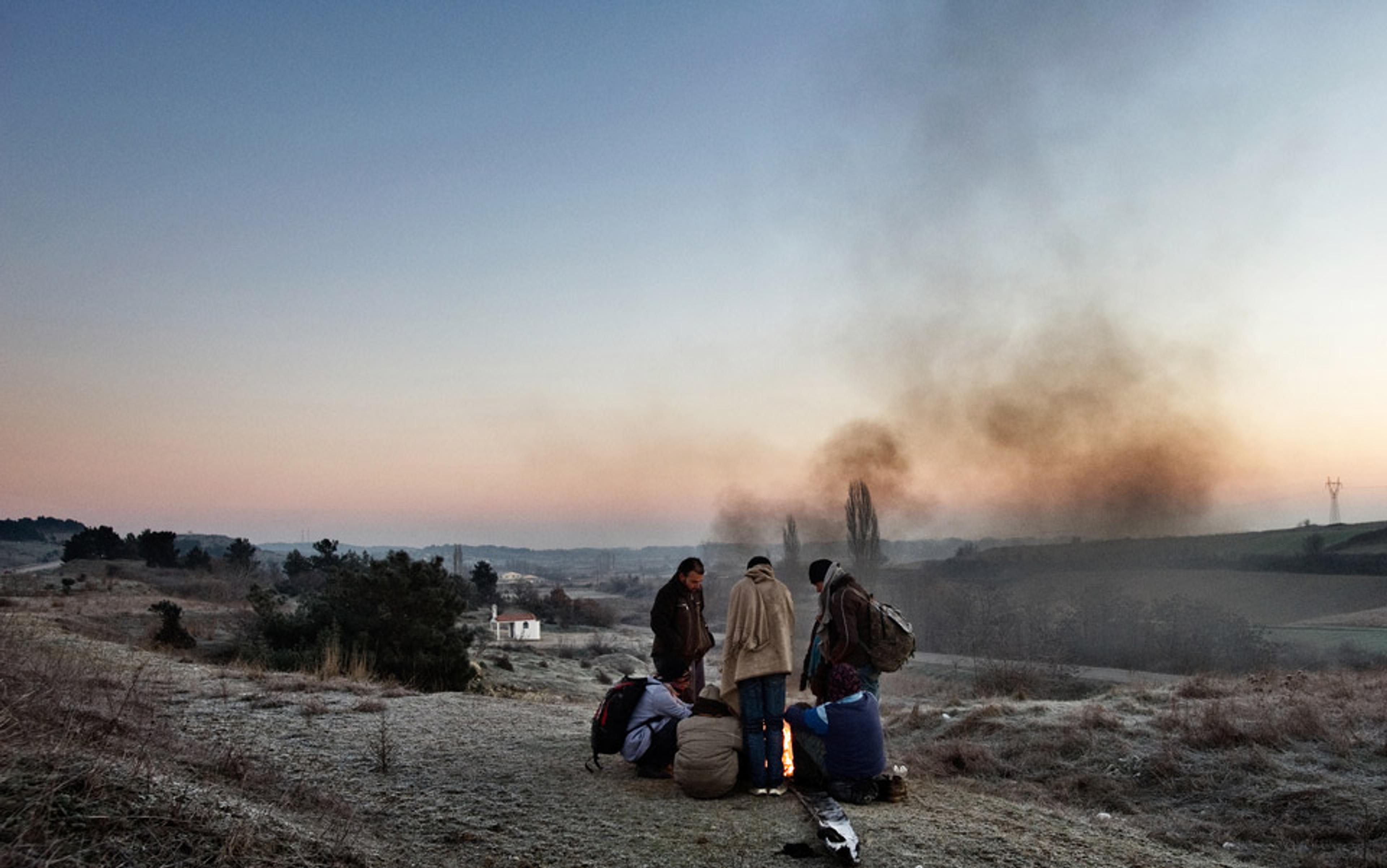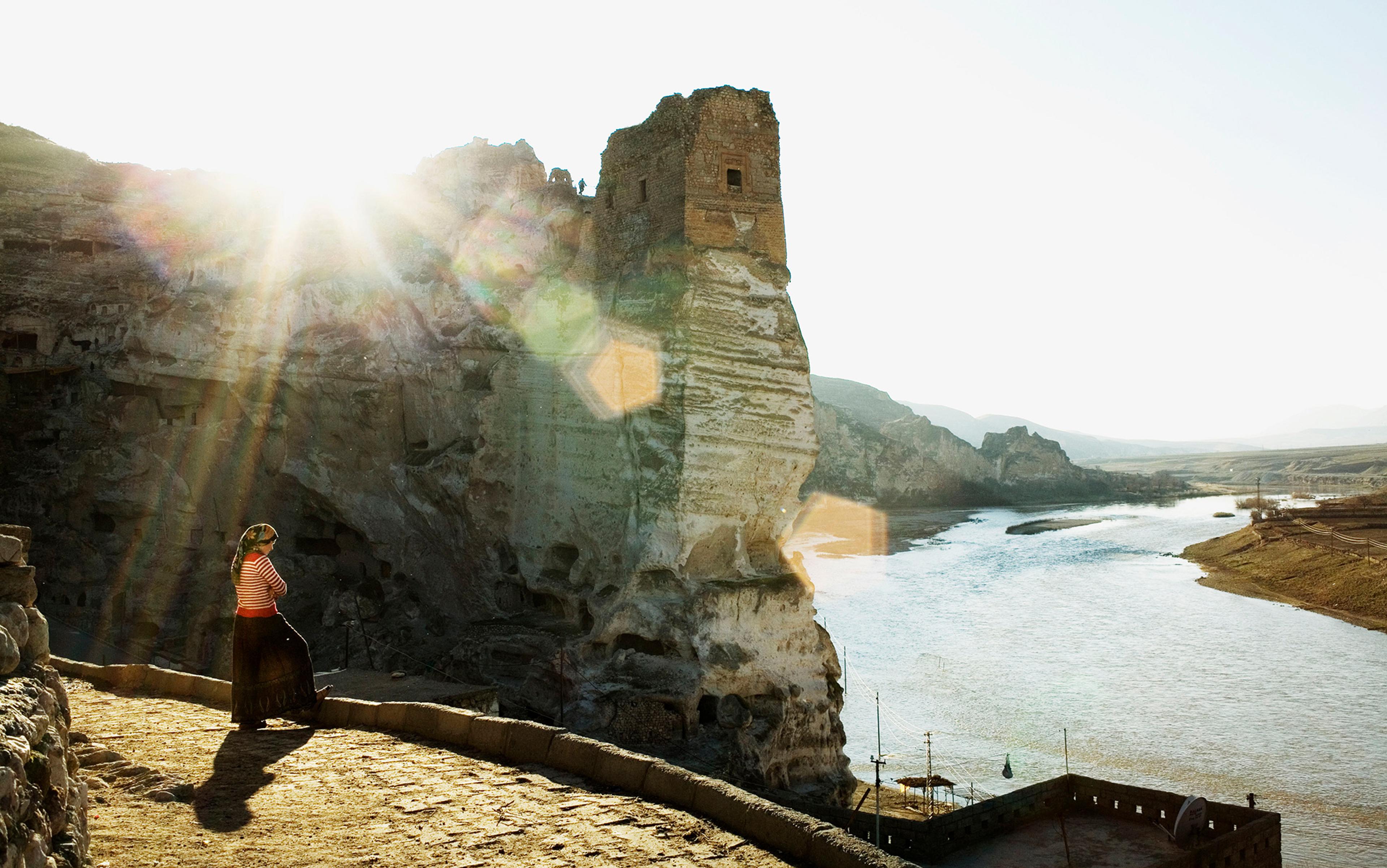On 17 October 2015, a ferry collided with a dinghy just off the coast near the Turkish port of Çanakkale. All 13 of the dinghy’s passengers drowned. They were Syrians heading for the Greek island of Lesbos, which has become the de facto gateway to the European Union for refugees from the dire Syrian civil war and the persecutions of Daesh.
In itself the event was depressingly unremarkable. The United Nations High Commissioner for Refugees (UNHCR) records that more than 3,500 Syrian migrants died or went missing at sea in 2014 alone. What is striking, perhaps, is rather the repetition of the pattern, to the extent that such tragedies have ceased to signify in their singularity. The identities of individual victims too went unreported in the west. It is as if the narrow sea separating the Turkish coast from the Greek islands of the eastern Aegean has been swallowing humanity itself, merging it into its own amorphousness.
The waters around Çanakkale have a particular significance as an intercontinental crossing-point. Here the warm, blue waters of the Aegean Sea narrow into a passage now known in the West as the Dardanelles. This strait, at its thinnest less than 1.5km wide, leads east into the Sea of Marmara and to Istanbul, the former Ottoman capital, which straddles the two sides, and which serves as the portal to and from the Black Sea. For millennia, this sliver of water – ‘where Europe flees from Asia’, as one Roman poet put it – has been evoked as the frontier between continents, as if nature herself were shaping the contours of our political imaginations.
At this point, where east and west could not be more geophysically proximate, the tensions between the two have historically been at their most intense. If we wish to understand the wider resonances of the current refugee crisis – why it matters so much to refugees to make the short but perilous sea voyage from Turkey to the eastern Greek islands, and why it matters so much to the European Union to return them – the Dardanelles is the place to start.
In the modern era, the northern, ‘European’ side of the strait, known as the Gallipoli peninsula, has long been Turkish territory; in fact, the modern state stretches some way further north into Thrace. It was the Ottomans’ annexation of the peninsula in 1354, and subsequent expansion into the fertile Balkans, that marked the starting-point of their own imperial age – and the crumbling-point of that of their rivals, the Byzantines, the heirs to the Roman empire. Culturally, however, there remained in Gallipoli a heavy cultural, linguistic and religious Greek presence until 1915, which saw the beginning of a grim period of ethnic cleansing.
Gallipoli is best known now for the First World War campaign that saw the British and French and their allies from New Zealand, Australia, India, and Canada attempt to occupy the peninsula in 1915 so that the fleet could force its way up the sea passage to capture Istanbul. The Turkish victory was partly the result of the tactical nous of a young lieutenant colonel called Mustafa Kemal, who would receive the name ‘father of the Turks’ (Atatürk) in commemoration of his role in the foundation of the modern state.
The Gallipoli campaign was a modern one, fought with cutting-edge warships and heavy artillery. But it also resounded with deeper historical echoes, as 20th-century, classically educated commentators were fond of observing. ‘The winds of history will follow us all the way,’ wrote the poet Rupert Brooke, as he set off with the British force; unfortunately he died of sepsis before arriving. It was across the Dardanelles in 334 BCE that Alexander the Great transferred his forces into Asia, at the start of an imperial adventure that would change the world. Alexander smashed the mighty Persian empire, and spread Greek language and culture across most of what is now the Middle East. He was retracing in reverse the crossing route of another celebrated invader. In 480 BCE the Persian king Xerxes sent his massive army across the strait, ahead of his unsuccessful attempt to subdue Greece. An epigraph from the Greek historian Herodotus begins the Australian Alan Moorehead’s classic 1956 book, Gallipoli, suggesting an analogy between Xerxes and the British commander-in-chief, Sir Ian Hamilton. In both cases, crossing the Dardanelles was the prelude to military disaster – as if the strait itself were reasserting the separateness of the continents.
Famously, Xerxes ordered his engineers to construct a pontoon bridge across the narrow passage. According to Herodotus, a squall destroyed the first bridge, and so the king commanded his men to whip the stormy waters and drop shackles into ‘the bitter sea’, making the point that he was the master and the sea his unruly slave. The story was almost certainly Greek propaganda designed to portray the Persian king as absurdly arrogant and contemptuous of nature, and the expedition as destined by hidden metaphysical forces to end in failure.
The Trojans were gradually merged into an all-encompassing stereotype of trouser-wearing, effeminate, decadent, eastern ‘barbarians’
Herodotus, though, got at least one thing right. By chance, a Babylonian map, inscribed in clay, survives from approximately Xerxes’ era; it is now in the British Museum. If Xerxes had consulted this or something like it (Babylon was under Persian control at the time) he would have found the Mediterranean named mar-ra-tum – ‘the bitter water’ – and would have learned that it was the westernmost section of a wild, unruly ocean that ringed and bounded the stable Asian land mass. It is, then, not at all unlikely that Xerxes, who had probably never left dry land before, reflected at this point on the Hellespont’s bitterness, confronting it with a mixture of trepidation and awe. Today’s refugees face a sea that has lost none of its bitterness; and they command none of the resources of a Persian king.
Some 30km to the south of modern Çanakkale lies the site of ancient Troy, where Homer located the legendary war for Helen that would become paradigmatic for the definition of Europe and Asia as defined and opposed spaces. Homer’s Trojans, in fact, are almost indistinguishable from the Greeks in terms of culture and religion; but later Greeks layered this story with their own ideological preoccupations, so that the Trojans were gradually merged into an all-encompassing stereotype of trouser-wearing, effeminate, decadent, eastern ‘barbarians’.
It is easy, then, to imagine this geophysical boundary between Asia and Europe, between East and West, as natural and inevitable, a site of conflict scored into the very continental landmass itself. But that, in fact, is very far from the case. Anatolia, roughly the western half of modern Turkey, was in antiquity hardly just a borderland. That picture holds true, perhaps, in some respects and for some periods. By 1,000 BCE, Greek settlers had founded colonies along the western coast, sometimes known as the ‘Ionian’ cities. These cities were captured by Cyrus in the 6th century, and the Persian empire added the ‘Yauna’ to its roll call of subject peoples. It was the Greeks’ encouragement of the cities to revolt in the early 5th century that was the catalyst for the Persian invasion. The Ionian cities, then, were frontier states of a kind. But long before arrival of the Greeks and the Persians, in the second millennium BCE, central Anatolia had been the hub of its own mighty empire, that of the Hittites, the influence of which was felt in Syria and Mesopotamia. As with so many parts of the ancient world, then, Anatolia’s historical role shifted over time. During some periods it was the buffer zone between regional powers; but at other times it was the regional power, and the margins of empire were located elsewhere.
Continents are the products of human political devising, not facts of nature. The boundary between Europe and Asia is, in fact, particularly hard to draw, because the two have so much more land in common to the north than the tiny sliver of sea that divides them in the Hellespont region. And crucially, even that sea itself was not originally imagined as a border. The earliest ancient texts from the region – Mesopotamian, Israelite, Egyptian and Greek – see the world in terms not of continents but of political territories, empires and states, the frontiers of which were ever expanding and contracting across seas, rivers and mountain ranges. In any case, until the emergence of Rome as an international player, all of the cultural and economic action in the Mediterranean was concentrated in the eastern corner, in the nook between Egypt and the Syro-Palestinian coast, Anatolia and Greece. The idea that Greeks had more in common qua ‘fellow European’ with Gauls and Spaniards in the west than with Phoenicians and Egyptians in the east and south would have been ludicrous. (And as for Germany, Britain and Scandinavia, forget it: those windy, distant territories were barely known to the classical Greeks.)
So where does the idea of continental difference come from? The name ‘Europe’ derives from Greek myth, certainly, but the myth in question does little to help solidify the continental boundary. The young Europa was not ‘European’ at all, but Phoenician, which is to say from modern Lebanon. Playing by the shore of the Mediterranean with her age-mates, the princess was drawn to a fine bull that had appeared nearby. After petting the beast, she climbed on to it, at which point the beast – who was, in fact, Zeus, the arch-rapist king of the gods, in disguise – surged into the sea and swam to the Greek island of Crete, where he mated with her; their offspring included the legendary Cretan king Minos. The story is about not ethnic differentiation, but the joint Phoenician and divine parentage of one of the legendary royal families of the Greek world.
The idea that the Hellespont is a point of natural rupture between east and west has its roots in Athens’s imperial fantasies of absolute dominance in the Aegean
How and why the name was later applied to the territory is not at all clear. What is certain is that it is Herodotus, the subtle and gifted ‘father of history’, who bequeathes us our earliest surviving account of continents. He knew of only three: Africa (which he called ‘Libya’), Asia and Europe. Herodotus was influenced by the intellectual revolutions of his age, when the Greeks’ horizons had suddenly receded: he knew not just of Egypt, the Mediterranean and Mesopotamia, but of Iran, Arabia, India and lands we now know as Armenia, Turkmenistan and Georgia, as well as many more. His ideas were partly an attempt to organise this expanded space conceptually. But the more important inspiration for his continental divisions was political. He was writing in the aftermath of Xerxes’s failed invasion of Greece in 480-479 BCE (which also formed the narrative climax of his Histories).
More than that, he was writing in Athens, which had built up a massive naval fleet on the pretext of defending Greece from further Persian attack – although the Athenians were also simultaneously extorting huge amounts of protection money from other Greek states, sometimes forcibly, cash that they used to beautify their own city. The idea that the Hellespont is a point of natural rupture between east and west, that here is the point where civilisations divide and clash, has its roots in Athens’s imperial fantasies of absolute military, economic and aesthetic dominance in the Aegean, and its manipulation of the politics of fear.
This stark, imperial-ideological division of east and west does not tell the whole story. Herodotus himself did not fully subscribe to this continental theory, which he saw as over-rigid and arbitrary. There is a reason for his scepticism. His own hometown of Halicarnassus, now Bodrum in Turkey, lay on the ‘Asian’ side. His father was probably not Greek but Carian (the Carians being a people who had lived in the region long before the Greek colonists had arrived, and who spoke their own language). What is more, ‘Europe’ as we would understand it held little interest for Herodotus: he virtually ignores Spain and France, and even Italy puts in only the briefest appearance. What captivated him were the ancient empires of the near-east, especially Egypt – ‘nowhere else are there so many marvellous things’ – and Babylon. He treats these civilisations not with disdain but with admiration. Generally, although easterners had some oddities, usually to do with food, burial or sex, and an undeniable tendency to despotism, he found their ways far from alien. ‘The customs of the Lydians,’ for example, ‘are like those of the Greeks (except that they treat their daughters as prostitutes).’
The geophysical model recorded by Herodotus, in fact, had little impact in antiquity. The idea of stable continents had little to recommend it in an era in which the boundaries of civilisations and empires were ever porous and mobile. It was not until the medieval period, when western, Latin-speaking Europe sought to differentiate itself ontologically from the worlds of both Islam and (to a lesser extent) orthodox Christianity, that the idea of continental difference took hold, and the Herodotean paradigm was embedded in the popular imagination. In antiquity by contrast, western Asia continued, by and large, to be seen as part of an integrated Mediterranean world.
And here’s the rub. In classical times, what we now think of as the frontier separating Europe from Asia was a point of juncture too; it was a place where cultures met and transacted. The earliest Greek philosophers, for example, were from Miletus, on the Anatolian coast some 50km north of Herodotus’s home-town. The first, Thales, who predicted an eclipse (and fell down a well), spoke Greek but was by origin a Phoenician whose name – apparently from thal, the Phoenician word for liquid – bespeaks not just his metier (he was a seafaring merchant) but also his preoccupation with water as the fundamental component of all things. Like his Milesian successors Anaximander and Anaximenes, Thales used the Greek language, but was deeply influenced by the ancient learning of the near east, and particularly by the Babylonians and their grasp of the regularity of the heavenly bodies. For traders like Thales, sailors who were now navigating the entire length of the Mediterranean, the sea was not the gulf that sundered cultures but the glue that bonded them, bringing new artefacts, stories and ideas.
It is easy to forget that for most in the ancient world the Hellespont was not a barrier between eastern and western lands at all, but a marine passageway facilitating travel. For the societies of the Mediterranean, as a rule, a voyage by sea was much easier and cheaper than by land. In the eyes of most ancients, the Hellespont was not the boundary between the two continents of Europe and Asia, but the sea lane that connected the Aegean and the Black Sea. Here, large amounts of grain were packed into ships to feed the hungry cities of Greece, whose own rocky soil could not support the massive population growth it had seen. When Athens and Sparta joined in a bruising war that dominated the 5th century BCE, one of the decisive events that sealed the Spartans’ victory was their seizing control of the Hellespont, which led to famine in Athens. Similarly, the opening up of the sea lane to the Black Sea was the ultimate aim of the Franco-British Gallipoli campaign in 1915. Even now, the Dardanelles is said to be the busiest shipping lane in the world.
Indeed, the strait took its ancient name – the sea (pontos) of Helle – from a journey not between continents, but along the marine path into the Black Sea. Helle and her brother Phrixus travelled not by ship, but on the back of a magical golden ram, which rescued them from the hostile designs of their stepmother Ino. The ram swam (or flew, depending on whom you read) from the Greek mainland across the Aegean, up the as-yet unnamed strait, across the Black Sea and to Colchis, a coastal city in what is now Georgia; Helle, however, tumbled to her death, and the Hellespont’s name commemorated its first recorded (but far from last) victim of drowning. Phrixus sacrificed the ram to Zeus on arrival at his destination, and so the famous golden fleece was brought into being, the object of the Argonauts’ quest. In some ancient traditions, the Argo was the first ship.
For the ancients, myths were not just stories, but powerful ways of imagining the world; and the myths around the golden fleece mapped out a world dominated by sea trade between the Aegean and the Black Sea, with the Hellespont at its fulcrum. In other words, the myth that named the strait tells not of the separation of continents but of the joining up of maritime trade routes.
Not everyone could afford ships, of course, but so narrow is the Hellespont that at its slimmest point it is just about swimmable, for the vigorous at least. In antiquity, a tragic romance was told about two lovers, Hero and Leander, who lived in the towns facing each other across the straits, Abydos and Sestos. Because Hero’s parents were jealously protective of her, there was no chance of legitimising their love. So Leander would swim every night to the solitary tower she inhabited by the shore, guided by the light of the lamp she placed in an upper window. One night as she waited for him by the shore a gust blew out the fragile flame. Leander, confused in the dark, lost his way and drowned. When Hero saw his body, washed up on the beach, she threw herself from the tower.
How Europe and Turkey respond to this unprecedented mass migration of the desperate will shape the futures of hundreds of millions of people
In May 1810, Lord Byron successfully recreated Leander’s swim. Nowadays there is an annual ‘swim Hellespont’ event, which has been repurposed as a celebration of the Turkish Victory Day, commemorating a decisive victory over Greek forces in 1922, which led to the establishment of the secular state under Atatürk. The event is still, at the time of writing, scheduled for August 2016, even though the ancient story has taken on new, grim resonances in the light of the refugee crisis. Like many a Leander, numbers of Syrians have been washing up dead on the shores of Turkey (as well as the eastern Greek islands, Sicily and north Africa) – among them, of course, Alan Kurdi, the three-year-old whose body appeared on the beach at Bodrum (ancient Halicarnassus, Herodotus’s home town) in September 2015, and whose image prompted a massive outpouring of sympathy across the world.
The sea has always claimed its victims. The story of Hero and Leander, however, is more about the human impediments to true love, in the form of the domineering control exerted by Hero’s parents. This is the keynote of the classical versions told by Ovid and Musaeus, and indeed of Christopher Marlowe’s version. In his reprise of the theme in Romeo and Juliet, Shakespeare did away entirely with motif of separation by natural obstacles, focusing instead on the barriers that human beings willingly choose to erect between themselves and others, and the destruction they wreak on younger generations. This complex of stories is about the human capacity for love and unity, and the violence that ensues when we enforce familial and political boundaries.
I do not wish to minimise the weighty political, economic and cultural challenges posed by the Syrian refugee crisis. How Europe and Turkey respond to this unprecedented mass migration of the desperate will shape the futures of hundreds of millions of people – not, of course, just the refugees themselves. But we should not ignore the historical dimension either. It is too easy to assume that frontiers between continents are stable, permanent and essentially resistant to crossing. The Dardanelles is not a ‘natural’ boundary between east and west, but a point of connection, where throughout history people have always interacted: armies and invaders, to be sure, but also aged thinkers, eager traders and young lovers. Crossing the sea between ‘Asia’ and ‘Europe’ is not an act of transgression. It is what human beings have done since ancient times.






